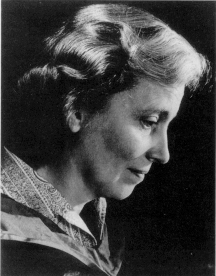

Dorothy Crowfoot, born on 12 May 1910 in Cairo, Egypt, obtained her first degree in chemistry at Somerville College, Oxford. Her x-ray crystallographic career started with her studies of thallium dialkyl halides with Herbert M. (Tiny) Powell in the department of mineralogy and crystallography at Oxford. She obtained a PhD at Cambridge University in 1937, working from 1932 to 1936 with John Desmond Bernal, who reinforced her lifelong interest in structural biochemistry.
In 1934 Bernal and Crowfoot first reported on the diffraction pattern of a protein crystal, pepsin, pointing out that protein crystals should not be dried but should be studied surrounded by their mother liquor (the standard method used since that time). The air-dried crystals gave very poor, if any, diffraction patterns, while those surrounded by mother liquor diffracted well.
Dorothy became interested in steroids while she was in Bernal's laboratory, and with Bernal and Isidor Fankuchen she studied crystals of over one hundred steroids and reported their unit-cell dimensions and the refractive indices with respect to these crystallographic axes. This monumental study of crystalline steroids showed, in the days before three-dimensional structure determinations, their probable crystal packing and hydrogen-bonding schemes.
Dorothy became a tutor and fellow of Somerville College in 1936. In 1937 she married Thomas Hodgkin, a tutor in adult education and a historian of Africa. She was made university lecturer and demonstrator in 1946, university reader in 1955 and Wolfson Research Professor of the Royal Society in 1960. One of her students was Margaret Roberts, later Margaret Thatcher, the only British prime minister with a degree in science.
With her student Harry Carlisle, she initiated a crystallographic study of cholesteryl iodide. Always on the lookout for new and better ways to solve structures, she pioneered the use of Patterson maps, using them to find the iodine positions; electron density maps using relative phases for the Bragg reflections based on these positions were then calculated. Dorothy had a particular ability to pick out a molecule from an electron density map with symmetry-related artifacts, such as were present in maps of the crystal structures of cholesteryl iodide and, later, penicillin. Cholesteryl iodide was one of the first analyses based on three-dimensional calculations, and it established the relative stereochemistry at each carbon atom of the steroids.
Dorothy's next big venture was the determination of the chemical formula of penicillin, which had been discovered in 1929. In 1944 Dorothy had some crystals of penicillin derivatives. The determination of the molecular structure of this compound was vital. A world war was in progress, and the best methods of production of penicillin to prevent wound infection were required. With Barbara Rogers-Low, Dorothy determined the structures of the sodium, potassium and rubidium derivatives of benzylpenicillin, using isomorphous replacement, optical analogs and difference maps. The molecule contained a four-membered ring of three carbon atoms and one nitrogen atom - this was the 13-lactam structure that had been assumed to be too unstable to exist independently. The chemical formula so determined served as the starting point for many chemical modifications that have been successfully used as antibiotics, such as the cephalosporins and thiosterpton, for which Dorothy also determined crystal structures.
In 1926 the fatal disease pernicious anemia had been found to be treatable by liver extracts, and in 1948 the active principal ingredient was isolated from liver in crystalline form as beautiful deep-red cobalt-containing crystals. E. Lester Smith brought them from Glaxo laboratories to Oxford so that Mary Porter and Reginald C. Spiller could determine if they were the same as those isolated by Karl Folkers at Merck Laboratories. Dorothy was excited at their appearance and immediately measured their unit-cell dimensions and molecular weight. She and her coworkers determined the structure and found that it was like that of a porphyrin ring with one bridging carbon atom missing so that two pyrrole rings were directly linked, and the B positions of these rings were each fully saturated. Dorothy used the cobalt atom to phase the hexacarboxylic acid derivative of vitamin Bl2, even though everyone advised her that it would not work because the scattering power of the cobalt atom was too weak with respect to the rest of the molecule. Later Galen Lenhert showed in her laboratory that the B12 coenzyme contains a cobalt-carbon bond, making this the first known naturally occurring organometallic compound. W. Lawrence Bragg, in Fifty Years of X-Ray Diffraction (Oosthoek's Uitgeversmaatschappij, Utrecht, The Netherlands, 1962), described the Bl2 study as "breaking the sound barrier," leading to new horizons in the field, namely the possibility of using heavy atoms to determine the structures of biological macromolecules, as had been suggested by J. Monteath Robertson in 1939. Since Dorothy's method worked for B12, people were encouraged to tackle the crystal structures of proteins.
Dorothy took the first x-ray diffraction photographs of insulin in 1935, and from then until the crystal structure was solved 34 years later, she was confident that the molecular structure could be determined from the x-ray diffraction pattern. The structure of 2Zn insulin was reported by Dorothy and her coworkers in August 1969. Chinese crystallographers, led by Tang You Chi, also worked on the crystal structure of insulin, and Dorothy traveled to China to compare the electron density maps of the two structure determinations. The diffraction patterns for insulin extended to very high resolution. After her retirement Dorothy, with Guy Dodson and his colleagues, published a definitive monograph on insulin.
Dorothy's influence on our understanding of biological structures has been unique, both through her firm belief that x-ray diffraction of crystals would give highly significant structural results and through her encouragement of young scientists who have gone on to expand the field themselves.
Obituary written by Jenny P. Glusker and Margaret J. Adams, Oriel College and Somerville College, Oxford, England